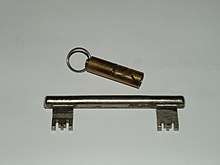Berlin key
The Berlin key (also known as, German, Schließzwangschlüssel, or, in English, forced-locking key) is a key for a type of door lock. It was designed to force people to close and lock their doors, usually a main entrance door or gate leading into a common yard or tenement block. The key was a solution to the problem of access via communal doors of such blocks (Mietskaserne) as early as the 19th century.[1]

Mechanism
A Berlin key has two key blades, at each end of the key, rather than the usual single blade. The key is used like this:
- Unlock the door from the outside
- Push the key through the lock, so that the key protrudes from the inside of the door
- Open the now unlocked door and enter
- Close the door and lock the door with the key, which now protrudes from the inside of the door
- Take the key from the lock
The mechanism makes it impossible to forget to lock the door, without also forgetting the key in the lock. Also, locking an open door is usually not possible.
Invented by the Berliner locksmith Johannes Schweiger,[2] the Berlin key was massively produced by the Albert Kerfin & Co company starting in 1912.[3] With the advent of more recent locking technologies, this kind of lock and key is becoming less common. It was estimated in 2005, that 8000–10000 are still in use today in Berlin, Germany [3].
Representations
The key is subject of the book The Berlin Key by science and technology studies professor Bruno Latour. According to Latour, this technical object is a decisive agent that can mediate the relationship between the tenants, users, and visitors of a building.[4] He also proposed that the key performs a "program of action" or a "script", which is "Please bolt the door behind you during the night and never during the day".[5] This indicates two meanings for the term hardware in terms of the key as a mechanism — a door lock and information processor.[5]
Another interpretation noted that the key reveals two social dichotomies as it draws the line between guarded and unguarded resources as well as between inhabitants and strangers.[6] The Berlin key was also used to reference the Berlin Wall when it opened in 1989.[4]
References
- Lovell, Sophie (2017). Berlin in Fifty Design Icons. London: Hachette UK. p. 20. ISBN 9781840917574.
- Ullmann, Petra (8 March 2000). "Vor fast 90 Jahren erfand ein Weddinger Handwerker den Durchsteckschlüssel" (in German). Der Tagesspiegel. Retrieved 19 August 2013.
- Sethmann, Jens (November 2005). "Der Siegeszug des Doppelschlüssels" (in German). MieterMagazin. Retrieved 19 August 2013.
- Schmidgen, Henning (2014-10-15). Bruno Latour in Pieces: An Intellectual Biography. Fordham Univ Press. ISBN 9780823263714.
- Martin, Reinhold (2016). The Urban Apparatus: Mediapolitics and the City. Minneapolis, MN: University of Minnesota Press. ISBN 9781452953113.
- Papakostas, Apostolis (2012). Civilizing the Public Sphere: Distrust, Trust and Corruption. Hampshire, UK: Springer. p. 25. ISBN 9781349669370.